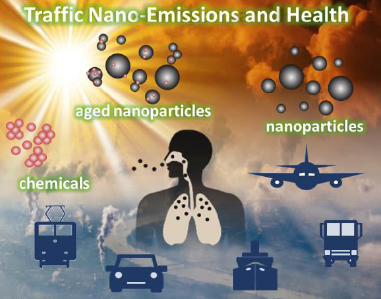ULTRHAS – ULtrafine Particles from TRansportation – Health Assessment of Sources
Motivation
According to the State of Global Air 2019 report, air pollution ranked fifth among all mortality risk factors in 2017, accounting for 5 million deaths and 147 million years of life lost, worldwide. An increasing number of studies indicate a role of chemical constituents from combustion emissions in cardiopulmonary effects. A ‘Trojan horse effect’ has therefore been postulated with combustion nanoparticles acting as carriers of volatile and semi-volatile chemicals and enabling access to organs and cellular compartments they otherwise could not reach.
Transport-related nanoparticles (particles ≤ 100 nm) from the exhaust and non-exhaust emissions, in atmospheric sciences referred to as ultrafine particles (UFPs), are variable entities with highly source-dependent properties. The health risks posed by different types and sources of UFPs and interactions between particles and gaseous components are not sufficiently captured by current mass-based regulations on the ambient air particulate matter (PM). Many primary exhaust components have a short half-life and are altered by atmospheric aging processes. The health impact of near-source and background pollutants, therefore, likely differ even when originating from the same source.
Aim of the project
ULTRHAS aims to determine the impact of UFPs from different transport mode emissions on human exposures and health, and clarify the importance of physicochemical characteristics and atmospheric processes applying cutting-edge exhaust generation and exposure approaches. The overall objective is to improve risk assessment of air pollutants and to advise policy-makers and regulators on more targeted mitigation measures against the emission components and sources that contribute the most to adverse effects. This will allow for more efficient initiatives to improve urban air quality and promote health and wellbeing. Briefly summarized, the project pursues the following main objectives:
- Generation of a comprehensive and publicly available registry on the physicochemical characteristics of nanoparticle emissions from a unique test battery of different transport modes (exhaust and non-exhaust from the road, rail, aviation, and shipping, as well as different fuel types), including both primary and secondary volatile and non-volatile UFPs and the impact of atmospheric aging processes
- Optimization of a toxicity testing strategy based on advanced lung and secondary tissue models in combination with air liquid interface exposure and the Adverse Outcome Pathway framework for the assessment of aerosol toxicity in the lung and beyond, validated by targeted animal studies.
- Improvement of the mechanistic understanding of the biological responses leading to adverse effects in multiple relevant tissues of transport mode emissions, focusing on carcinogenic and inflammatory responses.
- Hazard ranking of different transport mode emissions based on in-vitro and in-vivo toxicity outcomes
- Identification of the main physicochemical characteristics driving the biological effects induced by transport emissions.
- Health impact assessment of the various transport modes emissions based on in-vitro and in-vivo toxicological data in combination with integrated exposure pathway modeling and the intake-DALY approach.
- Socio-economic evaluation of the possible future impact of new policies in this area on public health and well-being of citizens.
- Contribution to the current discussion which metric is best suited to address the health effects of UFP-transport emissions and ambient aerosols.
Consortium
- Norwegian Institute of Public Health (NIPH)
- Helmholtzcentre Munich(HMGU)
- University rostock (UR)
- University of Eastern Finland (UEF)
- University of Fribourg, Switzerland (UFR)
- Finnish Institute for Health and Welfare (THL)
- Universität der Bundeswehr München (UniBw M)


